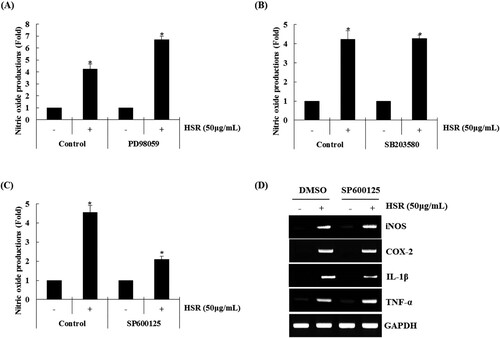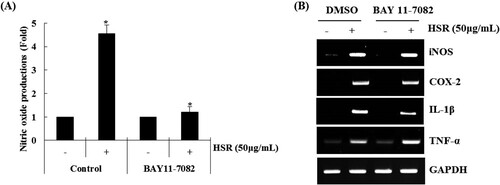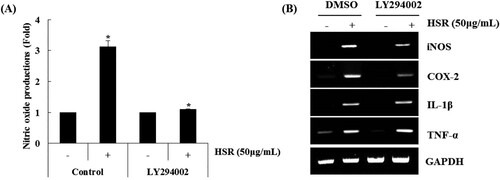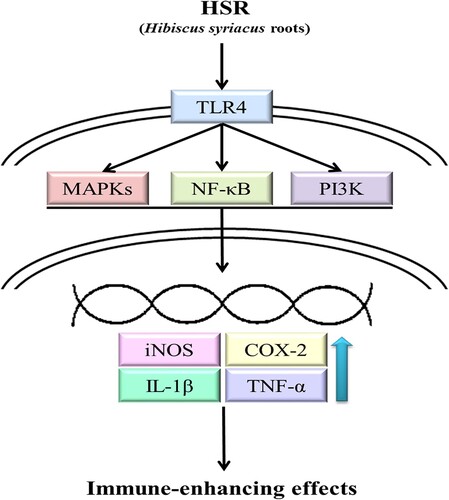Figures & data
Figure 1. Effect of HSR on macrophage activation in RAW264.7 cells. RAW264.7 cells were treated with HSR for 24 h. (A) NO level, (B) cell viability and (C) mRNA level were measured by the Griess assay, MTT assay and RT-PCR, respectively. *P < 0.05 compared to the cells without the treatment.

Figure 2. Effect of TLR2/TLR4 on HSR-mediated production of immunomodulators in RAW264.7 cells. RAW264.7 cells were pretreated with C29 (TLR2 inhibitor, 10 μM) or TAK-242 (TLR4 inhibitor, 10 μM) for 2 h and co-treated with HSR (50 μg/ml) for 24 h. (A) NO level (C29), (B) NO level (TAK-242), and (C) mRNA level (TAK-242) were measured by Griess assay (A and B) and RT-PCR (C), respectively. *P < 0.05 compared to that for cells without HSR treatment.

Figure 3. Effect of MAPK signalling pathway on HSR-mediated production of immunomodulators in RAW264.7 cells. RAW264.7 cells were pretreated with (A) PD98059 (ERK1/2 inhibitor, 20 μM), (B) SB203580 (p38 inhibitor, 20 μM) or (C) SP600125 (JNK inhibitor, 20 μM) for 2 h and then co-treated with HSR (50 μg/ml) for 24 h. NO level was measured by the Griess assay. (D) RAW264.7 cells were pretreated with SP600125 (JNK inhibitor, 20 μM) for 2 h and then co-treated with HSR (50 μg/ml) for 24 h. mRNA level was measured by the RT-PCR. *P < 0.05 compared to that for cells without HSR treatment.

Figure 4. Effect of NF-κB signalling pathway on HSR-mediated production of immunomodulators in RAW264.7 cells. (A and B) RAW264.7 cells were pretreated with BAY 11–7082 (NF-κB inhibitor, 20 μM) for 2 h and then co-treated with HSR (50 μg/ml) for 24 h. (A) NO level was measured by the Griess assay and (B) RT-PCR, respectively. *P < 0.05 compared to that for cells without HSR treatment.

Figure 5. Effect of PI3K signalling pathway on HSR-mediated production of immunomodulators in RAW264.7 cells. (A and B) RAW264.7 cells were pretreated with LY294002 (PI3K inhibitor, 20 μM) for 2 h and then co-treated with HSR (50 μg/ml) for 24 h. (A) NO level was measured by the Griess assay and (B) RT-PCR, respectively. *P < 0.05 compared to that for cells without HSR treatment.


